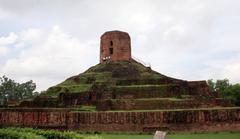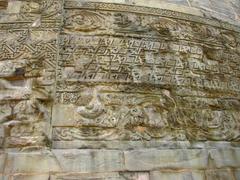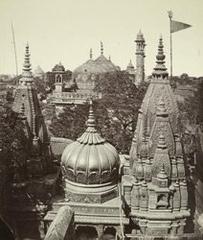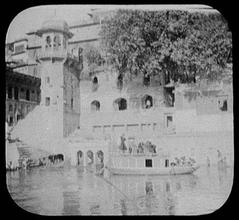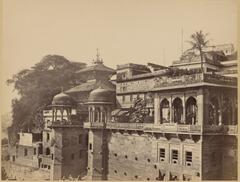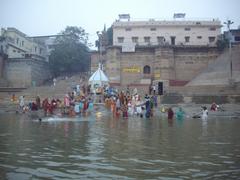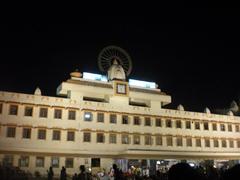
Sarnath Deer Park: Visiting Hours, Tickets, and Historical Significance
Date: 19/07/2024
Introduction
Table of Contents
- Introduction
- History and Significance
- Visitor Information
- Key Attractions and Landmarks
- Practical Information for Visitors
- Cultural Insights
- Frequently Asked Questions (FAQ)
- Conclusion
History and Significance of Sarnath Deer Park
The First Turning of the Wheel of Dharma
Sarnath’s association with Buddhism dates back to the 6th century BCE. After achieving enlightenment in Bodh Gaya, Buddha journeyed to Sarnath, drawn by the presence of five ascetics who had previously been his disciples. It was to this group, known as the ‘pañcavaggiya,’ that Buddha delivered his first sermon, often referred to as the “Setting in Motion the Wheel of Dharma” or the “Dharmacakrapavattana Sutta.”
In this seminal sermon, Buddha expounded on the Four Noble Truths:
- The truth of suffering (Dukkha) - Life inherently involves suffering.
- The truth of the cause of suffering (Samudaya) - Suffering arises from attachment and craving.
- The truth of the cessation of suffering (Nirodha) - Suffering can be overcome by eliminating attachment and craving.
- The truth of the path to the cessation of suffering (Magga) - The path to liberation is the Noble Eightfold Path.
The Noble Eightfold Path, encompassing right understanding, thought, speech, action, livelihood, effort, mindfulness, and concentration, forms the crux of Buddhist practice, guiding individuals towards enlightenment and the cessation of suffering.
Sarnath Through the Centuries - A Legacy of Patronage and Rediscovery
Following Buddha’s first sermon, Sarnath evolved into a major center of Buddhist learning and pilgrimage. The Mauryan emperor Ashoka, a fervent patron of Buddhism, played a pivotal role in establishing Sarnath’s prominence. In the 3rd century BCE, Ashoka erected numerous stupas and monasteries in Sarnath, including the iconic Dhamek Stupa, which stands today as a testament to his devotion and the site’s significance.
Over the centuries, Sarnath flourished under the patronage of various rulers and dynasties, attracting monks, scholars, and pilgrims from across the Indian subcontinent and beyond. Chinese Buddhist pilgrims, notably Faxian in the 5th century CE and Xuanzang in the 7th century CE, documented their visits to Sarnath, providing invaluable accounts of its flourishing monastic community and the numerous Buddhist structures that graced its landscape.
However, Sarnath’s fortunes waned with the decline of Buddhism in India and the advent of foreign invasions. By the 12th century CE, the once-thriving center of Buddhism lay in ruins, its magnificent structures crumbling under the weight of neglect and the ravages of time.
Sarnath’s rediscovery began in the late 19th century under British colonial rule. Archaeological excavations unearthed the site’s buried treasures, revealing the foundations of ancient monasteries, stupas, and sculptures of exquisite artistry. These excavations not only brought to light the historical grandeur of Sarnath but also reignited interest in its religious significance.
Visitor Information - Sarnath Deer Park Visiting Hours and Tickets
Sarnath Deer Park is open to visitors throughout the week. Here are the key details for planning your visit:
- Visiting Hours: Sarnath Deer Park is generally open from sunrise to sunset. However, it is advisable to check the official website or contact local authorities for the most up-to-date information regarding visiting hours.
- Tickets: An entry fee is required to access the archaeological site. Ticket prices may vary for domestic and international visitors. For the latest ticket prices, please refer to the official Sarnath Archaeological Survey of India (ASI) website.
Travel Tips and Nearby Attractions
- How to Get There: Sarnath is located approximately 10 kilometers from Varanasi, one of India’s most famous historical cities. You can reach Sarnath by taxi, auto-rickshaw, or local buses from Varanasi.
- Nearby Attractions: While in Sarnath, you can also visit the following attractions:
- Chaukhandi Stupa: A significant Buddhist stupa marking the site where Buddha met his first disciples.
- Ashoka Pillar: The remnants of the pillar erected by Emperor Ashoka, featuring inscriptions and a lion capital.
- Mulagandhakuti Vihara: A modern temple with beautiful murals depicting the life of the Buddha.
Key Attractions and Landmarks
Dhamek Stupa - The Crown Jewel of Sarnath
Dominating the Sarnath skyline, the Dhamek Stupa stands as a testament to the Buddha’s first sermon. This imposing cylindrical structure, reaching a height of 43.6 meters and a diameter of 28 meters, marks the very spot where the Buddha delivered his profound teachings on the Four Noble Truths and the Eightfold Path.
-
Historical Significance: Constructed by Emperor Ashoka in 249 BCE, the Dhamek Stupa replaced an earlier structure marking the Buddha’s sermon. Its foundation, encased in exquisitely carved stones, showcases intricate floral patterns and geometric designs, reflecting the artistic brilliance of the Mauryan era.
-
Architectural Marvel: The Dhamek Stupa’s grandeur lies in its simple yet powerful design. The cylindrical base, adorned with eight niches that once housed statues of the Buddha, symbolizes the Eightfold Path. The structure culminates in a massive stone platform, representing the attainment of enlightenment.
Mulagandhakuti Vihara - A Spiritual Oasis
Adjacent to the Dhamek Stupa lies the Mulagandhakuti Vihara, a modern temple marking the site where the Buddha is believed to have spent his first rainy season in meditation.
-
A Place of Tranquility: The temple’s serene ambiance provides a perfect setting for reflection and contemplation. Its walls are adorned with exquisite murals depicting scenes from the Buddha’s life, painted by renowned Japanese artist Kosetsu Nosu.
-
The Sacred Bodhi Tree: Within the temple premises stands a sapling of the original Bodhi Tree in Bodh Gaya, under which the Buddha attained enlightenment. This sacred tree serves as a powerful reminder of the Buddha’s teachings and the path to liberation.
Sarnath Archaeological Museum - A Treasure Trove of History
Established in 1910, the Sarnath Archaeological Museum houses an exceptional collection of Buddhist art and artifacts unearthed from the surrounding ruins.
-
Sculptural Masterpieces: The museum’s prized possession is the majestic Lion Capital of Ashoka, featuring four Asiatic lions mounted back-to-back, which has become an enduring symbol of India. Other notable sculptures include images of the Buddha in various postures, bodhisattvas, and deities, showcasing the evolution of Buddhist art over centuries.
-
Glimpses into the Past: The museum’s collection also includes intricately carved stone railings, pillars, and panels, offering insights into the architectural styles and religious practices of ancient India. Inscriptions on these artifacts provide valuable historical information about the Mauryan period and the spread of Buddhism.
Chaukhandi Stupa - Marking a Historic Encounter
Located about a kilometer from the main archaeological complex, the Chaukhandi Stupa commemorates the meeting of the Buddha with his first five disciples after attaining enlightenment.
-
Architectural Evolution: Originally a terraced temple dating back to the 3rd century BCE, the Chaukhandi Stupa was later surmounted by an octagonal tower during the Mughal period, showcasing a blend of architectural styles.
-
Panoramic Views: The stupa’s elevated location offers panoramic views of the surrounding countryside, providing a serene escape from the bustling city.
The Deer Park - A Serene Abode
Encompassing the entire archaeological complex, the Deer Park, known as “Rishipatana” in ancient texts, holds profound significance in Buddhist tradition.
-
A Symbol of Tranquility: The park’s tranquil ambiance, dotted with lush greenery and the gentle presence of deer, evokes a sense of peace and serenity, reflecting the Buddha’s teachings on compassion and non-violence.
-
A Place of Pilgrimage: For centuries, the Deer Park has been a revered pilgrimage site for Buddhists from around the world, who come to pay homage to the Buddha and retrace his footsteps.
Chinese Temple and Tibetan Monastery - Embracing Cultural Diversity
Reflecting Sarnath’s global appeal, the site also houses a Chinese Buddhist temple and a Tibetan monastery, showcasing the diverse cultural expressions of Buddhism.
-
Chinese Temple: Adorned with vibrant colors and intricate carvings, the Chinese temple features statues of the Buddha, bodhisattvas, and deities from Chinese Buddhist tradition.
-
Tibetan Monastery: The Tibetan monastery, with its distinctive architecture and colorful prayer flags, offers a glimpse into Tibetan Buddhist practices and rituals.
Practical Information for Visitors
-
Visiting Hours: Sarnath Deer Park is generally open from 6:00 AM to 6:00 PM. However, it is always best to check the latest timings on the official website or local authorities.
-
Tickets: Entry to most attractions in Sarnath Deer Park is free, but some sites like the Sarnath Archaeological Museum may have a nominal entrance fee. It is advisable to carry some cash for tickets and donations.
-
Accessibility: The site is well-connected by road and can be easily reached from Varanasi. Local transportation options include taxis, auto-rickshaws, and buses. The park and its major landmarks are wheelchair accessible.
Visitor Tips for a Memorable Experience
Respectful Attire
As Sarnath is a sacred Buddhist site, modest clothing covering shoulders and knees is essential. This shows respect for the religious significance of the place and is often required for entry into temples and monuments.
Best Time to Visit
- October to March: This period offers the most pleasant weather for exploring Sarnath, with warm days and cool nights.
- Avoid Peak Summer: The months of April to June can be extremely hot in Sarnath, making outdoor exploration uncomfortable.
Getting Around
- Walking: Sarnath is a compact site, and most attractions are within walking distance of each other. Enjoy a leisurely stroll through history and soak in the serene atmosphere.
- Rickshaws: For longer distances or if you prefer not to walk, readily available cycle rickshaws offer a convenient and local mode of transport.
- Taxis/Auto-rickshaws: Taxis and auto-rickshaws are available for hire from Varanasi city to reach Sarnath comfortably.
Accommodation
While Sarnath offers a few accommodation options, staying in Varanasi, with its wider range of hotels and guesthouses, is often more convenient. From Varanasi, you can easily plan day trips to Sarnath.
Food and Drink
- Vegetarian Options: As a prominent Buddhist pilgrimage site, Sarnath predominantly offers vegetarian food options. Many restaurants and eateries serve delicious Indian and international vegetarian cuisine.
- Stay Hydrated: Carry a reusable water bottle and stay hydrated, especially during warmer months. Bottled water is readily available at local shops.
Photography
- Respectful Photography: While photography is generally permitted, exercise discretion and refrain from using flash inside temples and monuments. Always seek permission before photographing monks or locals.
Shopping
- Souvenirs: Sarnath offers a variety of souvenirs, including Buddhist scriptures, statues, incense, and handicrafts. The local markets are great places to find unique and meaningful mementos of your visit.
Guided Tours
- Local Guides: Hiring a local guide can enhance your visit by providing in-depth knowledge about the history and significance of Sarnath.
Cultural Insights - Immersing in Sarnath’s Essence
Buddhist Teachings
- Dhammacakkappavattana Sutta: Familiarize yourself with the essence of the Dhammacakkappavattana Sutta, the first sermon delivered by Buddha at Sarnath, to gain a deeper understanding of the site’s importance.
- Engage with Monks: If you have the opportunity, engage in respectful conversations with resident monks. They can offer valuable insights into Buddhist philosophy and the significance of Sarnath in the Buddhist world.
Local Festivals
- Buddha Purnima: Witnessing the vibrant celebrations of Buddha Purnima, commemorating the birth, enlightenment, and death of Buddha, is a truly special experience. The festival usually falls in May and sees Sarnath adorned with lights and decorations.
- Dharma Chakra Pravartan Day: This day, marking the first sermon of Buddha, is celebrated with great reverence in Sarnath. Observe the processions and rituals to witness the living heritage of Buddhism.
Meditation and Reflection
- Embrace the Serenity: Sarnath’s tranquil atmosphere provides an ideal setting for meditation and reflection. Find a quiet spot amidst the ruins or in the Deer Park to connect with the spiritual energy of the place.
- Attend a Meditation Retreat: Consider participating in a meditation retreat at one of the monasteries or meditation centers in Sarnath. These retreats offer guidance and a conducive environment for deepening your practice.
Respectful Interactions
- Greetings: When interacting with locals, a simple “Namaste” with folded hands is a respectful greeting.
- Bargaining: Bargaining is customary in local markets, but always be respectful and polite during negotiations.
- Shoes Off: Remember to remove your shoes before entering temples and monasteries, a sign of respect in Indian culture.
By embracing these cultural insights and approaching your visit with an open mind and heart, you can create a truly memorable and enriching experience in Sarnath, connecting with its history, spirituality, and the enduring legacy of Buddha’s teachings.
FAQ
Q: What are the visiting hours for Sarnath Deer Park? A: Sarnath Deer Park is typically open from 6:00 AM to 6:00 PM. However, it’s best to verify the current timings before your visit.
Q: How much are the tickets for Sarnath Deer Park? A: Entry to most attractions is free, but some sites like the Sarnath Archaeological Museum may charge a nominal fee.
Q: How can I reach Sarnath Deer Park? A: The park is accessible by road from Varanasi, with local transportation options such as taxis, auto-rickshaws, and buses.
Q: Are there any guided tours available? A: Yes, guided tours are available and can be arranged through local tour operators or at the site.
Q: Is Sarnath Deer Park wheelchair accessible? A: Yes, the park and its major landmarks are wheelchair accessible.


